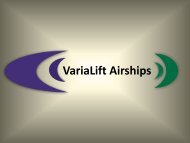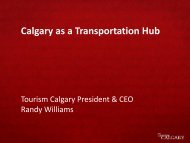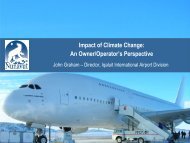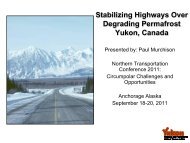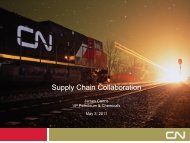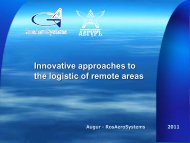Karen Hamberg & Graham Williams - Van Horne Institute
Karen Hamberg & Graham Williams - Van Horne Institute
Karen Hamberg & Graham Williams - Van Horne Institute
- No tags were found...
Create successful ePaper yourself
Turn your PDF publications into a flip-book with our unique Google optimized e-Paper software.
Advancing Technology For America’sTransportation FutureFindings of the NPC StudyWith An Emphasis on Natural GasA Presentation for the University of Calgary<strong>Karen</strong> <strong>Hamberg</strong>VP Sustainable Energy Futures, Westport Innovations<strong>Graham</strong> <strong>Williams</strong>Principal at GP<strong>Williams</strong> Consulting, Co-chair FTF Natural Gas SubgroupOctober 25, 20121
NPC Request from Energy Secretary Chu• Examine opportunities to accelerate future transportation fuels prospectsthrough 2050 for auto, truck, air, rail, and waterborne transport• Address fuel demand, supply, infrastructure, and technology• Factors to consider include:- Infrastructure- Technological advances- Economic competitiveness- Environmental (impact on GHG emissions, land, water)- Energy securityEntire Study and Topic PapersAvailable for Download at:www.npc.orgSupplemental Letter: April 30, 2010What actions could industry and government take to stimulate the technologicaladvances and market conditions needed to reducelife-cycle greenhouse gas emissions in the U.S. transportation sector by 50percent by 2050 relative to 2005 levels, while enhancing the nation’s energysecurity and economic prosperity?2
Study Structure3
Fuels Study LeadershipStudy Executive Committee LeadershipChairClarence Cazalot (Marathon)Government CochairDaniel Poneman (DOE)Demand Vice ChairGerard Vittecoq (Caterpillar)Supply & Infrastructure Vice ChairJohn Watson (Chevron)Technology Vice ChairJohn Deutch (MIT)SecretaryMarshall Nichols (NPC)Coordinating SubcommitteeChairLinda Capuano (Marathon)Government CochairDavid Sandalow (DOE)Supply & Infrastructure Task Group ChairShariq Yosufzai (Chevron)Demand Task Group ChairDeanne Short (Caterpillar)Technology Task Group ChairStephen Brand (ConocoPhillips)SecretaryMark Palfrey (NPC)Anthony Boccanfuso (University of S.C.)Chris W. Erickson (ExxonMobil)Michael Gallagher (Westport Innovations)Mitch Jackson (FedEx)Henry Kelly (DOE)Jan Mares (Resources For the Future)MembersPeggy Montana (Shell)Richard Newell (Duke University)Alan Taub (General Motors)Arthur Rypinski (Dept of Transportation)Chris Sultemeier (Wal-Mart)William Reinert (Toyota)Todd Werpy (Archer Daniels Midland)4
Subject Matter ExpertsArea Expert OrganizationEnergy Security and Policy (Chair) John Deutch Massachusetts <strong>Institute</strong> of TechnologyAgriculture – Biofuels Robert Fraley MonsantoApplied Physics and Policy Venkatesh Narayanamurti Harvard UniversityBatteries/Electrochemistry Yet-Ming Chiang MIT/A123 SystemsBiotechnology Jay Keasling UC Berkeley/JBEICryogenic Storage Tom Drube Chart IndustriesEconomics Robert Topel University of ChicagoEconomics Severin Borenstein UC BerkeleyEnergy Efficiency Amory Lovins Rocky Mountain <strong>Institute</strong>Engines John Heywood Massachusetts <strong>Institute</strong> of TechnologyEngines Robert Dibble UC BerkeleyHydrogen/Fuel Cells Henry White University of UtahMaterials Science/Nanotechnology George Whitesides Harvard UniversitySolar Fuels Daniel Nocera Massachusetts <strong>Institute</strong> of Technology5
Fuels Study DemographicsOver 300 ParticipantsBy Organization TypeBy SkillOther2%Consultant/Legal/Financial12%Oil & Gas Industry24%Policy21%Economics7%TransportManufacturers24%Gov't - Fed & State13%Technical70%End Users11%NGO9%Academia7%6
The Natural Gas TeamRocky Mtn<strong>Institute</strong>South CoastAQMDCARBLegendFuel SupplyEducation/ResearchAuto/EngineGovernmentFuel DemandIndustry AssociationMontreux EnergyCumminsWestportResourcesfor theFutureKenworthUSDAPeterbiltLA MetroNRELClean Energy FuelsEnCanaTIAXExxonMobilAir ProductsGasTechnology<strong>Institute</strong>CumminsCal PacificChevronMITUPSNGVAWestportInnovationsGeneralMotorsEnergy VisionBrookhaven NationalLabMarathonAgilityDOEChesapeakeUSDAGladstein,NeandrossChart IndustriesGP <strong>Williams</strong>ConsultingShellHondaCalstartAmericanWasteTrucking AssocManagementTrilliumTexas A&MJuniperMackay and CoZEV TechnologiesVolvoWalmartChryslerCaliforniaEnergyCommission7
Prudent Development: Realizing the Potential of NorthAmerica's Abundant Natural Gas and Oil Resources• The potential supply of North American natural gas is far bigger than wasthought even a few years ago• Oil resources also proving to be much larger than previously thought• We need these resources even as efficiency reduces energy demand andalternatives become more economical on a large scale• Realizing the benefits of natural gas and oil depends on environmentallyresponsible developmentPrudent Development is:Essential for public trust andconfidenceRequired for continued andexpanded accessFundamental for long termindustry successNorth American Natural GasWellhead Supply Curves8
Analysis And Findings9
Demand / Supply IntegrationDescribe an illustrative range of mobility demand for passenger and freight.Describe potential commercially available fuel/vehicle portfolio mixes meeting2050 mobility demand in an environmentally desirable, economicallycompetitive, and energy secure way.Analysis framed around AEO2010 key metrics,extrapolated to 2050.Vehicle miles travelled (VMT) increases by 60% to80% overall by 2050.⦁ Fuel economy improvements must offset this increasebefore net energy savings⦁ Fuel economy or fuel de-carbonisation must offset VMTincreases before GHG reductions can be realisedSignificant increases in oil prices with time, drivestransport fuel prices.10
Method of AnalysisIndividual Fuel / Vehicle OptionsAssessed potential to maximize commercial availability of individual supply chaintechnology pathways based on review of available reports and literatureReferenceCase(EIA AEO2010)BiofuelsFuel / VehicleSystemElectricFuel / VehicleSystemHydrocarbonLiquidsFuel / VehicleSystemBased on available research, for each fuel/vehicle supply chain:Natural GasFuel / VehicleSystem•Described fuel/vehicle supply chain pathways and supporting infrastructureHydrogenFuel / VehicleSystem•Identified opportunities and described technology options which significantly enhancesupply with improved environmental, economic, and energy security characteristics•Established upper and lower cost bounds for individual fuel and vehicle technologies•Developed “supply curves” and associated environmental impacts11
Priority TechnologyPriority Technology hurdles were identified that must be overcome for wide-scalecommercialization of advanced fuel-vehicle systems by 2050. A broad portfolio oftechnology options provides the opportunity to benefit from potential DisruptiveInnovations.• Over 250 hurdles evaluated, with 12 Priority Technologies identified• Systematic peer reviews by prominent academic and industry expertsFuel/Vehicle system:Light-Duty Engines & VehiclesBiofuelLight-Duty ElectricityLight-Duty Compressed Natural GasLight-Duty HydrogenMedium-/Heavy-Duty Engines & VehiclesPriority Technology advancement:- Low-cost lightweighting (up to 30% mass replacement)- Hydrolysis- Fermentation of C5 and C6 sugars- Lignocellulose logistics/densification- Production of higher quality pyrolysis oil- Biotechnology to increase food and biomass- Lithium ion battery energy density- Lithium ion battery degradation and longevity- Leverage liquid ICE fuel economy technology- Compression and storage for dispensing- Fuel cell degradation and durability- Combustion optimization12
Integrating Models to Assess Fleet Characteristics & MetricsNB. Fleet shares based on economics of driving (vehicle cost + fuel cost)In excess of 3,000 fleet portfolios investigated13
Heavy Duty Truck Market – Currently Diesel Dominated• Increasing demand forfreight movement• Almost entirely dieselfueled, and fleet fuelconsumption is increasing• Long haul, Class 7&8trucks consume >75% ofall the fuel – a key area forfocus• Fewer options fordiversifying fuel use thanLight Duty14
Range of HD Fleet Fuel Economy in 2050Technologies exist to increase new vehicle fuel economy by up to 100%, while stillproviding positive ROI, despite truck purchase costs becoming increasingly expensive.Opportunity to increase Fleet fuel economy by up to 50%.All Oil Prices15
Class 7 & 8 Market Shares of New Diesel and Natural GasTrucks: Reference & High Oil CaseNo expected penetration of Natural Gasin Class 7&8 in Low Oil Cases due toabsence of fuel price advantage.In Ref and High Oil Price scenariosmarket share for natural gas can be verystrong – based on fuel economics.Expect mostly LNG, starting in high fueluse fleet applications.Cost reductions and increasinglyaccessible dispensing required forgrowth, but could be compelling.16
Class 3-6 Market Shares of New Truck SalesReference Oil Case & High Oil CaseLower total fuel use in Class 3 to 6applications; more challengingeconomics for alternatives.However economic opportunity for SparkIgnition engines:GasolineCNGEconomics bolstered by cost avoidanceof increasingly complex dieselaftertreatment, replaced by TWC andEGR.Hybrid options exist and could findtraction in specific applications17
Impact of Diesel-Natural Gas Price Spread on Natural GasFleet Share in the Heavy-Duty Segment in 205018
Heavy Duty Fleet – Natural Gas Consumption• Combined consumption of Natural Gas in Classes 3 to 8 equates to between 1.5 and 3 TCF⦁ Annual US gas consumption today is ~ 23TCF, so HD trucks would increase NG demand by
Light Duty NGVs: A Deeper Look at Technology Potential• European state of the art demonstrates near term potentialfor fuel efficient, practical NGVs• Common powertrain architecture to gasoline; enablescommon technology advances for NGVs:– Downsizing, highly boosted engines, direct injection– CNG hybrids– Transmission– Chassis (light-weighting, aero)• Wide range of fuel economy potential• How do you optimize for economics when fuel costs are low?• Can scale and production integration reduce costpremiums?VW Passat TSI EcoFuelBi-fuel – CNG / GasolineIntegrated fuel storageprotects for luggage space• Historical issues of luggage space being resolved byOEM integration• Higher fuel use applications and vehicles likely to transition first.• Eg. – fleets and pick-ups• Greater infrastructure challenges for personal transport20
Light Duty - Cost of Driving ($2008)Assuming Technology, Infrastructure and Other Hurdles are Resolved21
Range of Light Duty Vehicle Fleet Shares in 2050(3 Year, All Oil Prices, All-in Technology Combination)Internal Combustion Engines remaindominant, but used with multiple fuelsand part of hybrid / PEV systems22
Range of LD Fleet Fuel Economy in 20503 Year Case, All Oil Prices23
Infrastructure and Other HurdlesInfrastructure challenges must be overcome for wide-scale commercialization of advancedfuel-vehicle systems. Options exist to facilitate concurrent development of alternative fuelvehicles and infrastructure, such as building on existing infrastructure, corridordeployment,and multi-fuel vehicles.Some examples are:• Overcoming transition costs and other challenges in moving from one fuel-vehicle system toanother• Concurrent deployment of vehicle and associated fueling infrastructure investments• Accelerating vehicle development cycle and market penetration• Building on existing infrastructure minimizing initial investment– Electricity and biofuels leverage existing grid and liquid fuel infrastructure– Natural gas leverage fuel distribution infrastructure in heavy-duty freight corridors– Localized, corridor, or niche-application deployment can improve dispensing infrastructure use• Flexible-fuel, bi-fuel and plug-in hybrids facilitate transition– Allow vehicle operation on fuel with more abundant dispensing– Build widespread availability of dispensing for the new fuel• Significant hurdles to overcome and investment required for infrastructure and vehicledeployment24
Infrastructure: Natural Gas Fuel Dispensing• Investment required, but technology options existFuel Production Fuel DispensingCNG (for LD) $0…? $100 - $200bnLNG $20 - $40bn $10 - $20bnHydrogen $30 - $90bn $300 - $500bnBio Gasoline $100 - $250bn $20 - $40bnElectricity TBD $70 - $130bnBio Diesel (GTL - BTL) …. ….FleetcentricCNG/LNGModular additionsto existing sitesUrbanFleetsHD FleetsPrivate LDFleetsPersonalLDConsumersIncreasing infrastructurerequirements as diversity of useincreasesDedicated newCNG/LNGstationsHome refueling25
Overall Fuel Economy and Fleet Fuel UseFuel economy can be dramatically improved in the light- and heavy-dutysectors through the advancement and application of existing and newtechnology. Internal combustion engine technologies are likely to be thedominant propulsion systems for decades to come, with liquid fuel blendscontinuing to play a significant, but reduced role.• Light weighting, improved aerodynamics, reduced rolling resistance, andhybridization and electrification can improve all vehicle types• Each fuel-vehicle system considered could become economically competitiveby 2050• This all comes at a cost, which impacts adoption in the market and thereforeoverall fleet fuel economy• Internal combustion engine technologies are likely to remain dominant fordecades to come(continued)26
U.S. Fleet – Total Fuel UseCombined Light and Heavy-Duty Vehicle Fuel UseFigure ES-13. Range of 2050 LDV and HDV On-Road Fuel Use,Assuming All Alternatives are Successfully Commercialized(3-Year, All Oil Prices, All-in Combination)NG :- 0 to 3 quad HD, 3 to 9 quad LD27
Greenhouse Gas EmissionsAnd Summary Insights28
Projected Range of Impact of Demand, Fuel Efficiency Improvements, andAlternative Fuel-Vehicle Systems on 2050 Heavy-Duty Fleet GHG Emissions(Reference Oil Price)29
Projected Range of Impact of Demand, Fuel Efficiency Improvements, andAlternative Fuel-Vehicle Systems on Light-Duty Fleet GHG Emissions(Reference Oil Scenario, 3- and 17-Yr)30
GHG EmissionsIf technology hurdles and infrastructure challenges can be overcome, economicallycompetitive low-carbon fuels and improvements in fuel economy will result insubstantial reductions in GHG emissions. Additional strategies will be required toachieve a 50% reduction in GHG emissions relative to 2005 in the transportationsector by 2050.• On a stand-alone basis, all light-, medium-, and heavy-duty vehicles have the potential toreduce per-mile GHG emissions by at least 40% in 2050, relative to 2005 average fleetlevels• Projected 2050 transportation demand, relative to 2005, counteracts per-mile GHGreductions• The Study did not identify any portfolio of fuel-vehicle systems that provides a clear andcost effective path to lowering transportation sector GHG emissions in 2050 by 50%relative to 2005– In the LD segment, a limited number of portfolios achieved a 50% reduction in this segment– No MD/HD portfolios achieved a 50% reduction in this segment• If disruptive innovations do not occur, then achieving a 50% GHG reduction will requireadditional strategies such as reducing electricity generation GHG emissions, reducingtransportation demand, improving transportation system operating efficiency, and/orother actions31
FTF Study Findings• Fuel economy can be dramatically improved in the light- and heavy-duty sectors through theadvancement and application of existing and new technology. Internal combustion enginetechnologies are likely to be the dominant propulsion systems for decades to come, withliquid fuel blends continuing to play a significant, but reduced role.• Priority Technology hurdles were identified that must be overcome for wide-scalecommercialization of advanced fuel-vehicle systems by 2050. A broad portfolio of technologyoptions provides the opportunity to benefit from potential Disruptive Innovations.• Infrastructure challenges must be overcome for wide-scale commercialization of advancedfuel-vehicle systems. Options exist to facilitate concurrent development of alternative fuelvehicles and infrastructure, such as building on existing infrastructure, corridor-deployment,and multi-fuel vehicles.• GHG Emissions: If technology hurdles and infrastructure challenges can be overcome,economically competitive low-carbon fuels and improvements in fuel economy will result insubstantial reductions in GHG emissions. Additional strategies will be required to achieve a50% reduction in GHG emissions relative to 2005 in the transportation sector by 2050.• Energy Security: In the years ahead, the U.S. transportation sector could have access to abroad array of economically competitive fuel-vehicle system options, the diversity of which cancontribute to our nation's energy security.32
Natural Gas Insights• The potential for a long-term and low-cost domestic supply of natural gas, driven byeconomically recoverable shale gas resources may provide an economic driver for theincreased use of natural gas for transportation.• There is an opportunity for LD and HD NGV to become attractive to both retail andfleet consumers. The economic competitiveness of these vehicles is contingent on asustained price spread between the lower cost of natural gas versus gasoline/dieselas a transportation fuel.• There are few technological barriers to market entry and expansion for either LD or HDNGV. Technology developments can be used to extend the performance andeconomics of NGVs through improved fuel economy and lower cost.• Enhancements in ICEs can generally be translated to natural gas engines.• Build out of infrastructure is critical to support the increased use of natural gas.Infrastructure build out for HD vehicles is more cost effective than the development ofwide-scale retail infrastructure for LD vehicles33
Natural Gas Vehicles: Summary Thoughts• Market opportunities for both LD and HDvehicles• Few technical barriers to NGV expansion• Similar powertrain architecture to gasolineand diesel is an advantage• Potential for a strong economic valueproposition if natural gas prices remainlow• Sustained effort required on infrastructureexpansion to resolve fuel availability• Continued market demand required tojustify expanded OEM product offerings34
Entire Study and Topic Papers Available for Download at:www.npc.orgThank you…<strong>Karen</strong> <strong>Hamberg</strong> (khamberg@westport.com)<strong>Graham</strong> <strong>Williams</strong> (graypwilliams@mac.com)35



